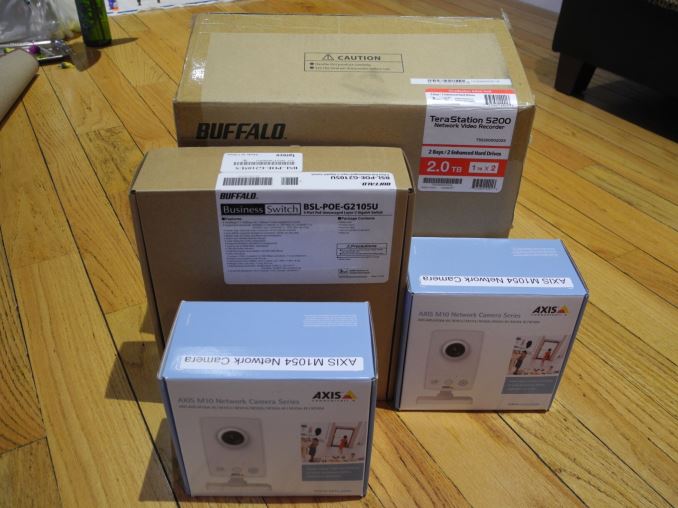Buffalo TeraStation 5200 Network Video Recorder Review
by Ganesh T S on July 31, 2015 8:00 AM EST- Posted in
- NAS
- IP cameras
- Buffalo
- NVR
Miscellaneous Aspects and Final Words
Power consumption is an important factor for systems that run 24x7 like the Buffalo NVR setup. The last 2-bay NVR that we reviewed consumed more than 27 W during operation, mainly because of the 7200 RPM enterprise drives that were pre-installed. Thankfully, Buffalo uses NAS drives (WD Red in our review sample) for the NVRs that ship with disks pre-configured. During operation, we found that the number of streams that were recording to the NVR (1 or 2) didn't actually cause too much shift in the power consumption. Interestingly, the impact of accessing the archived footage using the Axis Camera Companion was also minimal. We were also curious about the power consumption numbers of the PoE switch. Our observations are summarized in the table below.
| Buffalo TeraStation 5200 NVR Setup - Power Consumption | |
| TeraStation 5200 (2x 1TB WD Red) | 18.77 W - 20.58 W |
| BSL-POE-G2105U PoE Switch (no clients) | 4.52 W - 5.2 W |
| BSL-POE-G2105U PoE Switch with 1x Axis M1054 | 8.14 W - 8.82 W |
| BSL-POE-G2105U PoE Switch with 2x Axis M1054 | 11.53 W - 12.21 W |
Power consumption numbers are very reasonable, and a definite improvement over the LenovoEMC PX2-300D. The PoE switch also manages to remain fanless, thanks to its low power consumption profile. The TeraStation 5200 NVR is a proper NAS, and it had no trouble operating in degraded mode when one of the member drives in the RAID-1 array was pulled out. The cameras continued recording to the NAS even in that state and also during the rebuild process.
Coming to the business end of the review, we see that the TeraStation 5200 NVR with two 1TB drives comes in around $770 and the PoE switch is less than $90. There are a wide variety of compatible Axis cameras to choose from. For less than $900, we get a NVR setup which can also double up as a proper x86 NAS. This is a bit on the high end, but par for the course when comparable devices such as the LenovoEMC PX2-300D are considered.
It must be noted that the TeraStation NVR seems to have been created keeping only the Axis cameras in mind. Unlike the LenovoEMC PX2-300D NVR, the TeraStation 5200 NVR doesn't come with a VMS that runs on the NAS. Instead, most of the heavy lifting in terms of user-experience is done by the Axis Camera Companion. However, the Buffalo components enable the actual installation and usage by operating without hiccups in the background.
Except for the wiring part, the rest of the setup process has been simplified to a great extent. The process is intuitive and even non-tech savvy users could probably do a self-install. For others, a detailed how-to has also been created on Spiceworks by Buffalo. Recent firmware improvements to the Axis cameras (not available for all models, but applicable to the M1054 we used in the review) have made the configuration even more user-friendly for day-to-day usage. In terms of their target market (small businesses and home consumers), we believe that the partnership between Buffalo Technologies and Axis has resulted in a compelling IP surveillance solution.











12 Comments
View All Comments
Uplink10 - Friday, August 14, 2015 - link
A system with software which needs to connect to some server is secure? Not it is not, this is a security risk.Wwhat - Saturday, August 22, 2015 - link
"640x400"That's funny, to actually have a lower resolution than 25 years ago when you at least had 640x480.